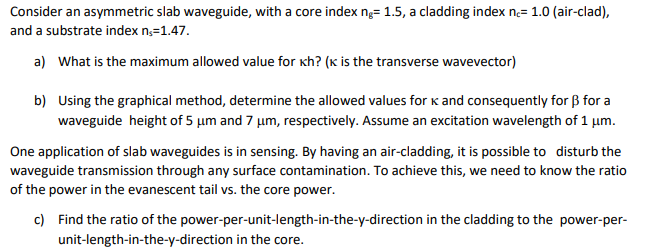Question

Transcribed Image Text:Consider an asymmetric slab waveguide, with a core index ng= 1.5, a cladding index ne= 1.0 (air-clad),
and a substrate index n₁=1.47.
a) What is the maximum allowed value for kh? (K is the transverse wavevector)
b) Using the graphical method, determine the allowed values for K and consequently for ẞ for a
waveguide height of 5 μm and 7 μm, respectively. Assume an excitation wavelength of 1 μm.
One application of slab waveguides is in sensing. By having an air-cladding, it is possible to disturb the
waveguide transmission through any surface contamination. To achieve this, we need to know the ratio
of the power in the evanescent tail vs. the core power.
c)
Find the ratio of the power-per-unit-length-in-the-y-direction in the cladding to the power-per-
unit-length-in-the-y-direction in the core.
Expert Solution
This question has been solved!
Explore an expertly crafted, step-by-step solution for a thorough understanding of key concepts.
This is a popular solution
Trending nowThis is a popular solution!
Step by stepSolved in 2 steps

Knowledge Booster
Similar questions
- h) The difference in arrival time between wave-packets with centre frequencies of ω1 and ω2 is Δt. What is DM in terms of Δt ?arrow_forwarddesign an ordinary end fire uniform linear array with only one maximum so that its directivity is 20 dB (above isotropic). The spacing between the elements is lambda/4 and its lenth is much greather than the spacing. Determine the (a) the number of elements (b) overall length of the array (in wavelengths) (c) approximate half-power beamwidth(in degrees) (d)amplitude level (compared to the maximum of the major lobe) of the first minor lobe (in dB) (e) progressive phase shift between the elements (in degrees)arrow_forwardA Fabry-Perot device contains two parallel part-reflective surfaces, each with a power reflection coefficient R = 0.9, separated by an air gap of 0.05 mm. The device is used at near-normal inci- dence with a transmission maximum at wavelength 600 nm. Calculate the coefficient of finesse, and the resolving power.arrow_forward
- You have decided to increase the detection range of your iphone14 with a highgain, directional parabolic dish antenna to be able to access more distant cell towers (somewhat more difficult to get into your pocket or purse, however). A 3m-diameter parabolic dish is readily available commercially, and the desired sinusoidal radio signal specification is for Emax = 0.10 µV/m. Assume the antenna absorbs all the radiation that is captured by the dish (100% efficiency): (a) What is the amplitude of the magnetic field in this signal? (b) What is the intensity, I, of the radiation received by the antenna? (c) What is the power received by the antenna?arrow_forwardneed answer itarrow_forwardOTS tutorial (a) Explain the origin of the transverse phase condition that results in the equation for a slab waveguide given below (b) (c) (d) (1) 2nd√/n²-n² 20 = mл+Sp Explain what happens if this condition is not satisfied? Ignoring the G-H shift term, rearrange this equation for n For a waveguide at a wavelength of 1.55um, a core index of 3.5 and a thickness of 2um, work out the effective indices for m= 1, 2, 3 and 4 What happens to the modal index as the m number increases? Why? Explain why the mode effective index for the m-1 is not 3.5arrow_forward
arrow_back_ios
arrow_forward_ios